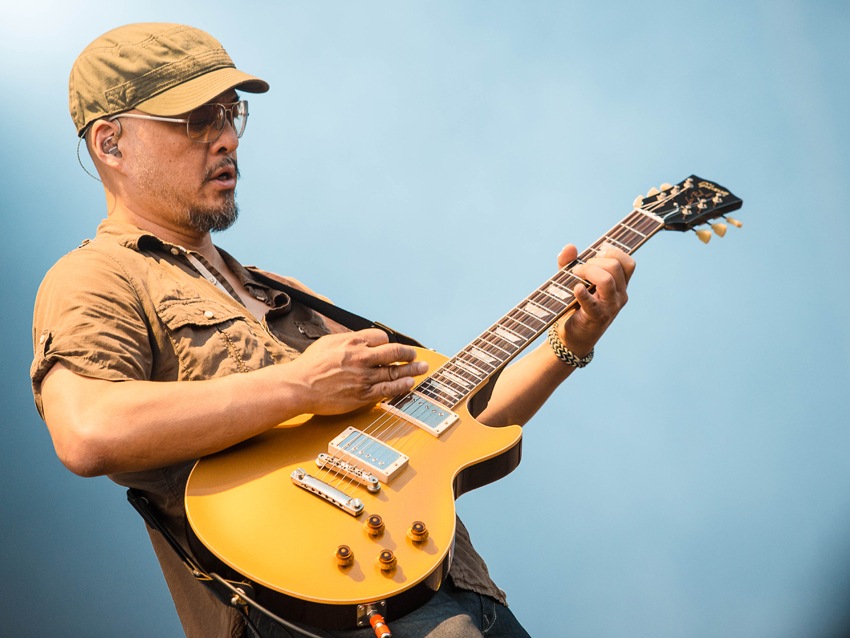
Joey Santiago talks guitars, tones and the Pixies' new album, Indie Cindy
It's been 10 years since the Pixies reunited, but it's taken over two decades – 23 years, to be exact – for the celebrated alt-rock band to release a follow-up to their last full-length record, 1991's Trompe le Monde.
At first, the group avoided the issue of tackling some new music, and then came a couple of false starts in the studio. Finally, last year, there was the gnashing track Bagboy, which gave way to three smashing EPs released in quick succession. And come April 28, all of the EP cuts, along with Bagboy, will be issued as Indie Cindy, which effectively puts the Pixies' album embargo to an end.
“I guess we were sort of dipping our toes back in the water with the EPs," says lead guitarist Joe Santiago. "But the other reason for releasing the album piecemeal was to lengthen the lifespan of the music. A lot's changed since we did this in the '90s. An album just doesn’t do anything now – it can be out there and only be coveted for a short period of time. So extending the release in this way made a lot of sense to us."
Santiago spoke to MusicRadar from a tour stop in Lima, Peru, to talk about the new album, working with longtime producer Gil Norton, how he and Pixies frontman Black Francis work on guitar tones, and whether he likes being called an "anti-hero" on the axe.
I was talking to Andy Summers recently, and I called him a guitar "anti-hero." You're in that category, I think. You don't go in for long solos, that kind of thing...
“That’s actually flattering if you call me an ‘anti-hero.’ There aren’t enough heroes out there, but still we need the yin to go with the yang, you know? I remember a big pow-wow at our hotel one night; everybody from Lollpalooza was there band-wise. I got to meet Kim Thayil from Soundgarden. We took a picture – me and Charles [Thompson aka Black Francis] with Kim in the middle – and Kim said, ‘Here’s to the unproficient guitar players!’ [Laughs] We loved that.
“Guitar technique never interested me. I've always been in love with sounds. There’s a lot of people who have technique already, so I’ve just never been interested in that. From day one I was just interested in sonics. I remember one time my guitar was out of tune. I kept hearing this one note that wasn’t in harmony – it was shaking, but I loved it. A friend of mine said to me, ‘Dude, that’s out of tune, you know.’ And I said, ‘That’s right, and I don’t care. At least one string’s in tune.’ [Laughs] That’s kind of the way I feel about it all.
With a lot of guitarists, you can pinpoint their influences right away – probably because they mimic other players so much. Your influences are difficult to spot. I hear some surf guitar, more of a traditional approach to sound.
“Well, that’s good, I guess. Yeah, there’s the surf thing, definitely. The Shadows, Link Wray, The Ventures – I listened to The Ventures a lot in the latter days of college, when Charles and I were about to drop out. I liked the fact that that one word, ‘surf,’ describes the music. There’s a song called Jack Knife by Like Wray – ‘surf like a jack knife.’ And there’s Run Chicken Run – obviously, that sounds like a chicken. Then there’s Apache and all that stuff… Even Hawaii Five-O sounds like this big surf’s comin’ at you. Well, maybe it’s because of the visual, but it does sound like that. I just like the description of that one word: surf. I use that, too, in the Pixies. I take one word and I run with it.”
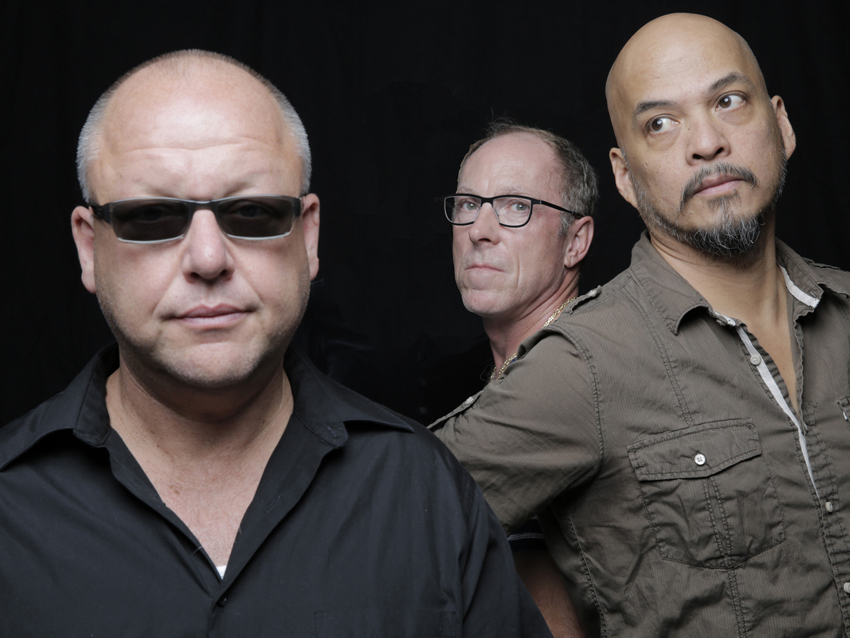
On the Pixies' guitar sound
Above photo: Pixies, 2014: (from left) Black Francis, David Lovering, Joey Santiago.
Kurt Cobain said that he was trying to write a Pixies song when he wrote Smells Like Teen Spirit. With Nirvana now in the Rock And Roll Hall Of Fame, does that make you think, “Hey, why not us?”
[Laughs] “That’s really… God, we don’t aspire to that. I mean, it’d be nice. It’d be a nice feather in the cap, for sure. But if we do make it, there’s a lot of other people that need – need – to be in there. Cheap Trick aren’t in there, and they should be. I was surprised that Donovan was inducted only a few years ago. That’s just ridiculous.
“I think it’s just a silly process. I don’t know if they have a quantity limit. And what the fuck is that about? Why does there have to be a quantity? I don’t know how many they choose – nineteen? And then they’re hemming and hawing about the 19th one, arguing about it. It’s just silly. ‘Cheap Trick against Donovan – who are we gonna pick?’ It’s asinine, really. I guess they don’t want to have a show that’s too long for the audience. It’s showbiz rearing its ugly head.”
The musical paradigm of the Pixies – the loud-quiet-loud conceit, the harsh guitars on top of soft vocals – is one of extreme contrasts. Was this something the band consciously constructed, or did it all just happen on its own?
“It was by accident. I think the lack of technique and being an anti-guitar hero, if you will, corners you into a specific niche. If you discover something, which we did, then you just run with it. I like that. I’m not jealous at all of people who know theory. I have to work for it. And I'm OK with working for it. When you’re in the studio and you’re looking for that particular note, sometimes that leads you somewhere cool.”
How do you and Charles generally go about working on your tones together?
“It’s pretty natural – Charles has a Tele and I’ve got a Les Paul. He’s really good at rhythm guitar; he’s just got it down pat. My guitar will be a little thicker and will cut through more. You can’t have two Teles, and you can’t have two Les Pauls; you’ve gotta have one or the other. The Clash is a good example of that.”
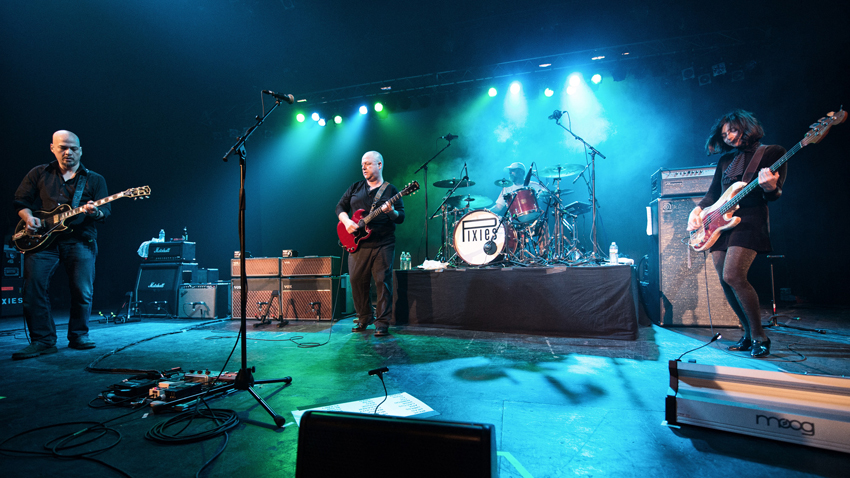
Working with producer Gil Norton
Above: The Pixies on stage (with touring bassist Paz Lenchantin, right) at the Orpheum Theatre, Boston, MA, January 18, 2014.
The material on Indie Cindy was recorded in 2012. You had tried before then, right?
“We tried it three times, actually. At one time it was David, Charles and me in my studio. I was too consumed with engineering it, so I didn’t really get to do my parts. I think Charles wanted us to jam it out in one go, but that didn’t happen. It could have happened, but my room is too tiny.
“The second time we tried it, we failed miserably. And then Kim Deal mentioned to the manager, ‘Maybe Charles and Joey should go back together like in the old times.’ That’s the way we presented it to the band, to harken back to the old times. In college, Charles and I had a handful of songs, and we worked them out with David and Kim. That’s the way it was, and that’s how we approached the successful method – the tried and true.”
The new material was produced by Gil Norton, who worked with the band on three other albums. What does he bring to the music that really works for you guys?
“We’re comfortable with Gil. He’s like a psychologist for us, and he’s used to the oddball ways that we work. He knows how to deal with our quirks. In fact, we were concerned that a new producer would just run away screaming. [Laughs] And also, a new producer wouldn’t know the arc of the next step of Trompe le Monde. This is it, and Gil nailed it. This is what we had to do for the first release in 20 years.”
You used Simon Archer as the bassist on the new recordings. Was there ever any talk of him joining the band to replace Kim?
“No, not at all. We need a feminine element to the band. That’s the way it’s always been. We equated it to Bon Scott, when he unfortunately passed away. If AC/DC got a woman to replace him, it just wouldn’t be good.”
Ring The Bell is a great song. You don’t do solos per se, but your guitar parts are very prominent throughout. The lines you play are very sweet and they ring out – appropriately. Was that on a Les Paul?
“No, no. For that, I heard that phrase – ‘ring the bell.’ So I thought, ‘What’s the most bell-like guitar I have?’ And it’s my Rickenbacker 12-string. You can’t get more ringing than that. Playing that, you’ll get the bell, the image.” I love that song. I like the arrangement. It has these kind of surf guitar parts to it.”
Magdalena is a gorgeous song. And there’s the hard guitars juxtaposed with very soft vocals.
“Yeah, yeah. But you know, that comes very naturally for us. We don’t even think about it. It’s just like us walking around.”
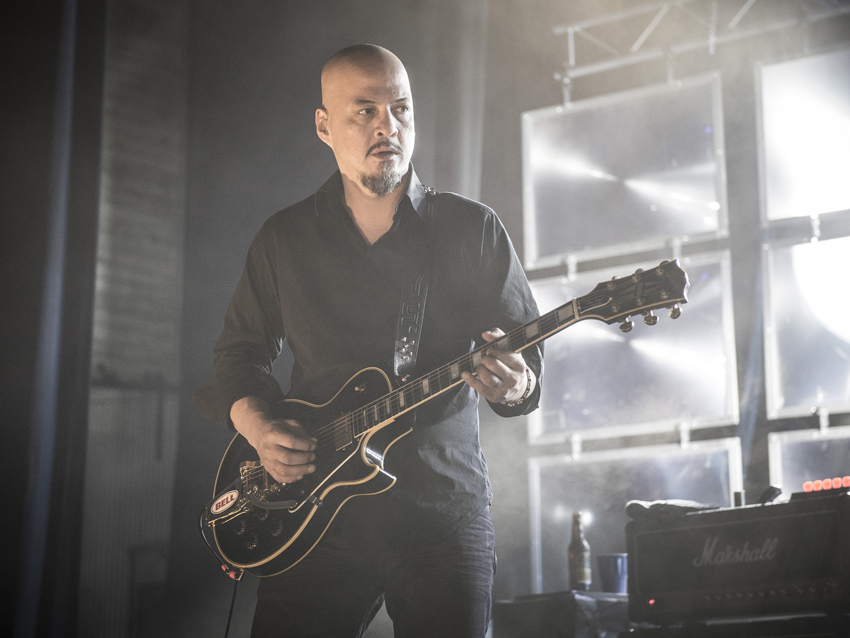
On his Les Paul Black Beauty
We’ve been using the word “surf,” and there it is on Indie Cindy, almost a Duane Eddy sound.
“Charles came up with that weird riff, actually. The sound… We just hear a part, and then we go, ‘All right, that’s the sound for that bit.' It’s really about coming up with the right tone, one that cuts through the rest of the music.”
Are you still using your 1960 Goldtop reissue?
“Yeah. The original one is what’s still being used. It’s the cheapest one, too, but it sounds good. I got lucky with the pickups, and I like the thin neck on that guitar. It makes sounds that really stand out, a very pointy kind of tone.”
And you have the ’57 Black Beauty.
“That’s right, the one with the Bigsby. Les Pauls are interesting – each one has a different sound, really. The black one is very full-bodied; all of the frequencies of a chord are just right there. It’s good for live shows, that one.”
You also use an 1965 ES-345 a lot. Are there specific uses for it?
“Oh, definitely. It’s my go-guitar for clean sounds; it just sounds best that way. It’s got a certain charm that I like. Les Pauls aren’t really meant for clean sounds – that’s what I think anyway. I know some people use 345s for distorted sounds, but I can’t really find the right use for it in that way. If I’m looking for a Les Paul sound, it’s not going to come from that guitar – ever.”
On stage you’re mixing up the dirty and clean sounds with a Marshall JCM 800 and a Fender Vibrolux. How did you come to use that combination?
“This was the first tour that we did that on. We didn’t want the redundancy of two Marshalls – that just wasn’t making sense. The new album has rings to it, so I need that, but I need the dirty, too. The Fender has a very upfront sound, and the Marshall is more squishy. Between the two, it’s perfect. One night, the mixing board wasn’t working right, and it just decided that it didn’t want the Fender in there. I started to freak out, like, ‘Where is that sound?’ When it came back on, I was like, ‘Ah, there it is!’ I needed that punch.”
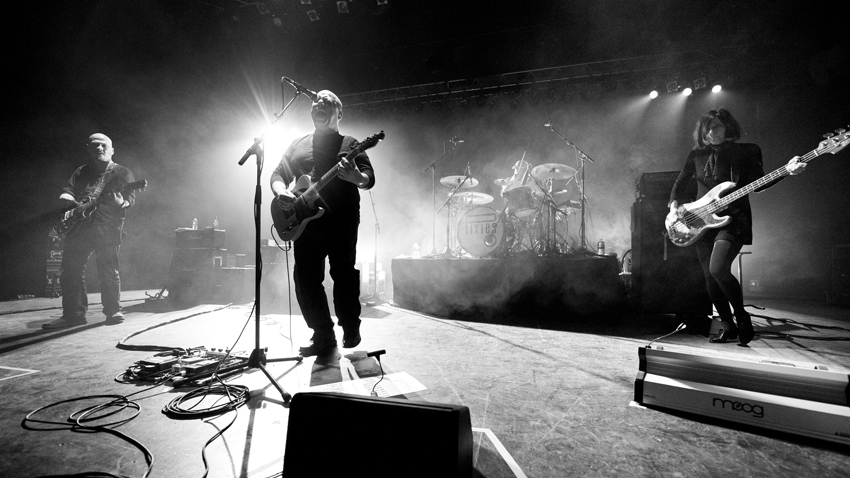
On touring bassist Paz Lenchantin
Afer Kim left, Kim Shattuck of The Muffs was in the band briefly. Now Paz Lenchantin is your touring bassist. Has there been any talk of making her permanent?
“If anybody would be a full member, it would be her. We absolutely love her. I know that she has Charles’ vote, and she has my vote. We’ll see in the future how it goes. We’ll see if she has good bedside manner in the studio. I mean, she has it now. She’s just good, you know? She’s got a good stage presence, and she’s funny off the stage. She laughs a lot. We have this very light thing in the band now – finally.”
I take it this is something that was lacking for a while?
“Yeah, it used to be there, but it faded. Paz brought back that thing that you’re supposed to actually enjoy this job. [Laughs] It shouldn’t be too much work.”
The band is nearing its 30th anniversary. Can you believe it?
“That's something, isn't it? We were celebrating Charles’ birthday, and he nudged me and said, ‘Not bad for a couple of college drop-outs.’ Sure, we’re surprised about it. Sometimes we sit on the bus and we talk, just us and our manager, and we say, ‘Look at us – we’ve got a moving house. Can you believe how lucky we are?’ It’s pretty amazing.”
The Pixies' Indie Cindy can be pre-ordered at Amazon. The double vinyl gatefold LP edition can be pre-ordered at this Amazon link. And a limited-edition deluxe double CD can be pre-ordered at pixiesmusic.com.
Joe is a freelance journalist who has, over the past few decades, interviewed hundreds of guitarists for Guitar World, Guitar Player, MusicRadar and Classic Rock. He is also a former editor of Guitar World, contributing writer for Guitar Aficionado and VP of A&R for Island Records. He’s an enthusiastic guitarist, but he’s nowhere near the likes of the people he interviews. Surprisingly, his skills are more suited to the drums. If you need a drummer for your Beatles tribute band, look him up.
